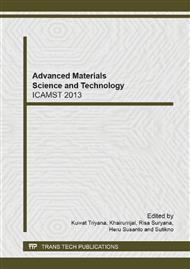p.280
p.284
p.288
p.292
p.296
p.300
p.305
p.310
p.314
Synthesis of Smart Biodegradable Hydrogels Cellulose-Acrylamide Using Radiation as Controlled Release Fertilizers
Abstract:
Smart biopolymer-based hydrogels was synthesized by graft copolymerization of acrylamide onto the rice straw cellulose backbones using simultaneous graft copolymerization by gamma radiation as initiator. Evidence of grafting was obtained from comparison of FTIR of the cellulose and grafted cellulose. The effect of acrylamide monomer concentration on grafting efficiency, gel fraction, swelling degree, crosslink density, molecular weight between crosslink (Mc), network mesh size (ξ) and Young Modulus were examined. It was found that grafting efficiency, gel fraction, crosslink density, and Young Modulus increases with increasing acrylamide concentration. Swelling degree, molecular weight between crosslink, and network mesh sizes decreases with the increasing acrylamide concentration. Furthermore, controlled release fertilizers from loaded hydrogels was analyzed in water. The urea fertilizer release mechanism from the hydrogels were Fickian diffusion. The diffusion coefficient of urea closely related to its crosslink density and network mesh sizes.
Info:
Periodical:
Pages:
296-299
Citation:
Online since:
February 2014
Authors:
Price:
Сopyright:
© 2014 Trans Tech Publications Ltd. All Rights Reserved
Share:
Citation:


